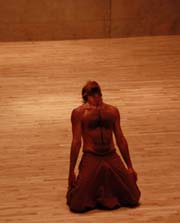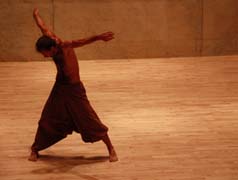
Jack Anderson
"New Russian Choreography: An Informal Showing"
Russian Sampler CEC ArtsLink:
Judson Memorial Church, Washington Square South, Greenwich Village
Reviewed by Jack Anderson July 6, 2009
We all know about Russian ballet. But what about Russian modern dance (or contemporary dance, or whatever you want to call present-day non-balletic theatrical dance)? It's scarcely known here. Yet it does exist. And, to judge from this showing, it may be worth knowing.
 |
| Leonid Glukhov in "Russian Sampler." Photo by Macha Gharibian |
This summer, four young choreographers from four dance organizations in four Russian cities came to the United States for a two-week residency hosted by CEC ArtsLink and the American Dance Festival which culminated in an evening of solos. This single modest occasion doesn't warrant sweeping assertions and, of course, it's impossible for anyone knowing little about the field to tell if these pieces are typical of contemporary Russian dance as a whole.
Nevertheless, it was an agreeable occasion. The solos, all performed by their choreographers, were emotionally intense, yet admirably concise (the longest, and it was much the longest, lasting only 13 minutes). The dancers were strong movers: wherever they may have studied, they've received sound training. They're apparently uninterested in doing "postmodern" pieces based on deliberately "pedestrian" non-dance movements. But neither did there appear to be a wish to flaunt the virtuosity associated with any standard pedagogical syllabus.
All these choreographers surely know that, abroad, "Russia" and "ballet" are sometimes almost synonymous. In "The Emptiness in Me," Olga Zimina (Center of Contemporary Dance, Krasnoyarsk) possibly alluded to tensions existing between ballet and contemporary dance. Wearing a tutu-like costume recalling Degas, she stood enclosed within a little rectangle, doing distorted balletic steps until she squirmed from both tutu and ballet to hurtle across the floor, covering space with speed and abandon, only to return at last to the rectangle.
 |
| Leonid Glukhov in "Russian Sampler." Photo by Macha Gharibian |
A desire to break loose also seemed evident in "Significance," which began with Natalya Podkovyrova (Acid Rain Dance, Chelyabinsk) looking rigid until she trembled with growing intensity, turned wildly, and rolled on the floor, clutching her feet and toes. She, too, struggled out of a confining costume.
A fragment from an untitled unfinished work begun this summer found Maria Samsonova (OKNO Dance Project, Saint Petersburg) emphasizing contrasts between big reaching gestures and shrinking withdrawals and, in her last moments, she alternated between covering her eyes and staring wide-eyed.
 |
| Masha Samosonova (top), and Natalya Podkovyrova (below). Photo by Chelsey Morell. |
Movements may have been angels or demons possessing the man portrayed by Leonid Glukhov (PRO-dvizheniya Dance, Novosibirsk) in "Untitled Solo." His steps, although carefully crafted and controlled, nevertheless created the illusion of being forces ready to knock him off-balance. He gave the impression of being an ascetic or monk, and there were bits of breast beating and moments when he crossed himself. So it came as no surprise when he said, during a post-performance discussion, that one theme of this dance of turbulent mood changes was "the Russian soul."
It's tempting, and possibly arrogant, for us to inject all sorts of social, political, philosophical, and aesthetic implications into what, after all, were only four short solos. Yet, even while knowing little about the civic and cultural contexts from which these dances emerged, it was good to find them worth thinking about as well as looking at. I would certainly be happy to see more by these choreographers.
The evening ended with everyone together in an untitled group improvisation to music by Macha Gharibian (piano), Lorenzo Sanguedolce (saxophone), and Jacob Wise (clarinet). As the dancers crept about the floor and hugged the walls, their improvised proceedings appeared more stilted than their fixed choreography. But that's how less than successful improvisations from any nation often look. These dancers had never met before this summer. Perhaps, if they had been better acquainted, their improvised interplay might have been more imaginative.
| museums | NYTW mail | recordings | coupons | publications | classified |
